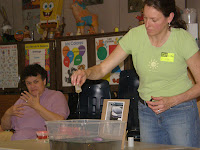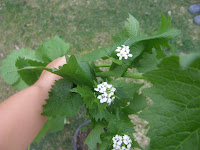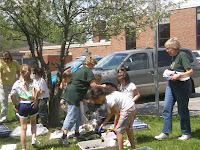On May 3rd, I had the pleasure to be a volunteer at Eastover Elementary School's
Nature Scavenger Hunt, Marvelous Mulches and the Rouge River. Hosted by
Lillian Dean and SOCWA Master Composters, a group of volunteers and the 2nd grade class all participated in a program to bring an awareness to the children about plant growth, decomposition and composting, invasive weeds, storm water runoff, proper tree mulching and much more.
 |
Volunteers getting last minute instructions
|
The purpose of the event was to demonstrate ways the boys and girls could help improve water quality in the Rouge River Watershed. The Rouge River is getting cleaner.... but needs every one's help to keep it that way including the young 2nd graders.
 |
| Kendra Knorp and Freddie |
The afternoon, a very warm 90 degree day, started off with Mary Koerner, Kendra Knorp and Lillian Dean presenting
'A Fishy Story' about Freddie the Fish. Freddie lives in a small northern branch of the Rouge River. As he starts from his clean home he meanders through the countryside, past forests and through subdivisions and city neighborhoods with commercial areas. Eventually the river and Freddie reach the fast flowing Detroit River, part of the Great Lakes system.
 |
| Mary Koerner and Freddie |
Along the way, Freddie encounters constructions sites where the water is filled with eroding soils. He passes by a farmer's field and fertilizers are washing into the river. As Freddie passes through each of these areas, Kendra and Mary sprinkle soil, fertilizers, oils, chemicals and even dog poop, into the once clean water that Freddie started out in. The kids were asked "How do you think Freddie feels now?" How can they stop the pollution to Freddie and all the animals and plants that call the Rouge River home?
 |
Children watching the overflow from the
parking lot and impervious surfaces. |
The children were then taken outside and the volunteers escorted them to the culvert in the parking lot that carries the storm water overflow from the asphalted surfaces to the river and eventually a pond running along the school and fire station property all part of the Rouge River system. As the firemen flooded the area the culvert was overflowing with debree carried along. The children could witness first hand how garbage and items that should never be in the water get there.
 |
| Garlic Mustard Alliaria petiolata |
Next stop was informing the children about the invasive plant 'Garlic Mustard'. It was enlightening to see how many knew of the plant and several even had participated in garlic mustard pulls in their subdivision. Garlic Mustard is an invasive biennial plant that can produce up to 3000 seeds per plant. Garlic Mustard seeds remain viable for many years. It chokes out native wildflowers, depletes the soil nutrients and destroys the beneficial mycorrhizal fungi in the soil. The kids learned to gently pull and try to get as much of the root, and as we walked through the woods, they spotted several plants and were eager to pull them out.
 |
| Composting demonstration |
We walked through the woods surrounding the school and looked for decomposers, under logs and under the leaves on the ground. As we walked the children collected the leaves to use in making compost. We shared the benefits of composting and how the soil helps the plants and even our lawns. It was discussed how to correctly cut lawns leaving the height of 3-4 inches. Surprisingly, several of the children knew about the lawn height. Though all too young to yet cut the lawn, they expressed they would share this with their parents.
 |
Lillian and the children mulching
the trees. |
The last stop was tree mulching. It was explained how trees and their roots are very important to water absorption and erosion. We then correctly mulched around several of the trees. First adding a layer of newspapers to kill the weeds and then placing compost and the mulch several inches thick over the newspapers. It was explained that the tree roots grow in the top 18 inches of the soil. A 2-4 inch layer of mulch over these roots provides the benefits for tree growth and health to the tree. Mulch helps keep lawn mowers away from the roots.
A wonderful learning experience was had by all. Volunteers, children and teachers shared a day outside being reminded how fragile and important the water we so dearly need is important to keep clean.






